
HOME
INTRO
SYMBOLS
ALMANAC
ECONOMY
GEOGRAPHY
STATE MAPS
PEOPLE
FORUM
NEWS
COOL SCHOOLS
STATE QUIZ
STATE LINKS
BOOK STORE
MARKETPLACE
NETSTATE.STORE
NETSTATE.MALL
GUESTBOOK
CONTACT US


Tweet
Double click any word in document for definition.
Texas State Cotton Gin Museum
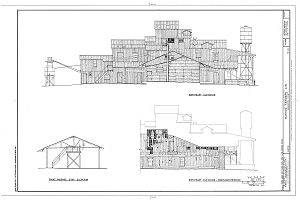
Texas State Cotton Gin Museum: Burton Cotton Gin & Museum
Library of Congress: Historic American Buildings Survey
Northeast Elevation
The Burton Cotton Gin & Museum became the Lonestar State's official cotton gin museum when Governor Rick Perry signed House Concurrent Resolution No. 71 on June 19, 2009.
"The Burton Farmers Gin represents the turn of the century revolution of cotton ginning from a labor intensive operation to the system gin which was powered by a single engine. It represents a mechanical age before the industrial use of power, and is the oldest surviving example of Robert Munger's concept of an integrated system of processing cotton from the wagon to a completed bale."
("Burton Cotton Gin & Museum")
In 1997 Governor George W. Bush signed House Concurrent Resolution No. 228 declaring cotton to be the official fiber and fabric of the State of Texas.
H.C.R. No 71
CONCURRENT RESOLUTION
WHEREAS, The State of Texas has customarily recognized a variety of official state symbols as tangible representations of the state's historical and cultural heritage; and
WHEREAS, The Burton Cotton Gin & Museum, in Burton, Washington County, is home to what is believed to be the only restored gin of its time period in the United States that remains in its original building, on its original site, and that operates with equipment that was in the facility when the gin closed; beyond its uniqueness, this plant represents a significant chapter in Texas agricultural and economic history; and
WHEREAS, First grown in Texas by Spanish missionaries, cotton became an important source of income in the state in the 19th century and has remained a significant part of the state's economy; Texas has led the nation in cotton production in almost every year since 1880, and the state's annual cotton harvest today constitutes approximately a quarter of all the cotton raised in the United States; the largest cash crop in Texas, cotton has been designated the official State Fiber and Fabric; and
WHEREAS, Beginning in the 1870s, cotton culture in Texas expanded dramatically: between 1869 and 1879, the number of bales produced in the state rose from approximately 350,000 to more than 800,000, and by 1900 the number of bales reached more than 3.5 million; this soaring volume placed a heavy strain on the existing gins and their mode of operation; even if steam engines were used instead of animals to power the gin machinery, manual labor was still needed to shift the cotton from one operation to another, and as cotton harvests increased, impatient farmers were forced to wait in ever longer lines at the gin; and
WHEREAS, To cope with the upsurge in production, Robert S. Munger, of Mexia, devised a radically new process that became known as system ginning; over the period from 1883 to 1892, he created pneumatic technology that would move the cotton in a continuous manner, directly from the wagon to the gin stand and then to the baling press; modern-day cotton gins still use the process that he pioneered; and
WHEREAS, Though highly successful, Mr. Munger's technology was too expensive for a single individual to install, and so local farmers would establish associations to build system gins; in 1913, a group of Burton agriculturists, most of them German Texans, incorporated to construct and operate the Burton Farmers Gin; designed by the Lummus Cotton Gin Company, the gin relied on Mr. Munger's pneumatic system, together with special air-blast equipment to doff lint from the gin saws; and
WHEREAS, During the 1920s, the mechanization of cotton harvesting necessitated the addition of still further machinery at the Burton gin, in order to remove the increased volume of trash from the seed cotton; the total power requirement then exceeded the capacity of the gin's original steam engine, and the latter was thus supplanted in 1925 by a Bessemer Type IV diesel engine with 125 horsepower; after that engine failed in 1963, it was replaced by an electric motor, though the diesel engine was repaired and kept as a standby power source; and
WHEREAS, The Burton Farmers Gin operated from 1914 to 1974, by which time cotton production in the area had almost wholly given way to the raising of livestock; efforts by local citizens to preserve the gin and return it to its 1930s condition began in 1986; as part of the initial phase, the complete gin records, which chronicle cotton production and sales by area farmers as well as the history of the physical plant, were indexed and archived; later, staff from the Smithsonian Institution assisted with the restoration of the gin's Bessemer engine, the "Lady B," which is considered to be "the largest operating internal combustion engine of [its] vintage in the southern United States," and one of the "few, if [indeed there are] any, engines of this age and horsepower in operation outside of a museum"; and
WHEREAS, Today, the Burton Farmers Gin constitutes the main structure in the nine-acre complex known as the Burton Cotton Gin & Museum; the gin itself is open for tours year-round and is activated twice a year, during the Cotton Gin Festival in April and the First Bale Celebration in October; listed on the National Register of Historic Places, the Burton Farmers Gin has also been designated a Texas Historic Landmark by the Texas Historical Commission and a National Historic Engineering Landmark by the American Society of Mechanical Engineers; and
WHEREAS, A key element of the cotton industry, gins were once a fixture in countless rural Texas communities and a fundamental part of their local economy; today, the Burton Cotton Gin & Museum evokes that earlier time and offers a rare window into a critical technological advance, one that continues to benefit the Lone Star State; now, therefore, be it
RESOLVED, That the 81st Legislature of the State of Texas hereby designate the Burton Cotton Gin & Museum as the official Cotton Gin Museum of Texas.
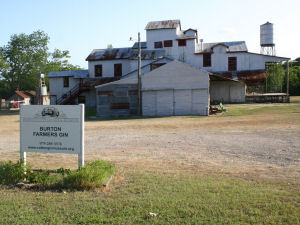
Texas State Cotton Gin Museum: Burton Cotton Gin & Museum
Photograph: Jerry Winfield. Used with permission.
Northeast Elevation
Texas Law
Because the Burton Gin & Museum was named the official gin museum of the State of Texas by Concurrent Resolution, it is not listed in the Texas Statutes.
Only a small number of Texas' myriad symbols have been actually adopted by an act of the legislature and written into the Texas Statutes.
Sources...
"House Concurrent Resolution No. 71." Texas Legislature Online. The State of Texas, 19 Jun 2009. Web. 16 Nov 2011.
"The Burton Farmers Gin." Burton Cotton Gin & Museum. Burton Cotton Gin & Museum, n.d. Web. 16 Nov 2011.

Additional Information
Burton Cotton Gin & Museum: Website of the official cotton gin museum of the State of Texas.
Cotton Ginning: The Texas Historical Association: Handbook of Texas Online.
Cotton Gins in Texas: Vintage Postcards - Series One - From The Will Beauchamp Collection.
Texas Cotton Ginners Association: Official website.
More symbols & emblems: Complete list of official Texas state symbols from NETSTATE.COM.
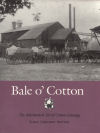
Bale o' Cotton
Karen Gerhardt Britton
Bale o' Cotton: The Mechanical Art of Cotton Ginning, by Karen Gerhardt Britton. 160 pages. Publisher: TAMU Press; 1st edition (November 1, 1992) Bale o' Cotton: The Mechanical Art of Cotton Ginning offers a unique blend of fact and folklore about cotton ginning, the process that takes cotton from the field, separates fibers from seeds, and packages the lint into a bale for shipment to market. It traces the development of the industry, the equipment, and the techniques of this integral facet of American life from its English beginnings in 1793, through its heyday in the American South, to its present technological peak.
Out of the long days spent in the gin plant, a rich oral tradition developed, which included a broad sense of general history and an understanding of worldwide markets, an appreciation for the music of the machine (especially the steam engine), legendary individuals, and a folklore based on practical jokes. But the language, traditions, and cultural practices that developed around the cotton gin are now rapidly becoming extinct as modern technology eliminates the risks, inventiveness, and close working relationships between ginners and machines.
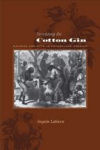
Inventing the Cotton Gin
Angela Lakwete
Inventing the Cotton Gin: Machine and Myth in Antebellum America, by Angela Lakwete. 248 pages. Publisher: The Johns Hopkins University Press (August 12, 2005) In Inventing the Cotton Gin, Lakwete explores the history of the cotton gin as an aspect of global history and an artifact of southern industrial development. She examines gin invention and innovation in Asia and Africa from the earliest evidence to the seventeenth century, when British colonizers introduced an Asian hand-cranked roller gin to the Americas. Lakwete shows how indentured British, and later enslaved Africans, built and used foot-powered models to process the cotton they grew for export. After Eli Whitney patented his wire-toothed gin, southern mechanics transformed it into the saw gin, offering stiff competition to northern manufacturers. Far from being a record of southern failure, Lakwete concludes, the cotton gin—correctly understood—supplies evidence that the slave labor–based antebellum South innovated, industrialized, and modernized.
Winner of the 2004 Edelstein Prize given by the Society for the History of Technology.

Ginning Cotton
A. L. Vandergriff
Ginning Cotton: An Entrepreneur's Story, by A. L. Vandergriff. 293 pages. Publisher: Texas Tech University Press (December 15, 1996) His first job was in a cotton gin at the age of nine. As an octogenarian, A. L. Vandergriff still had not lost his commitment to advancing technology in the industry he loved. Ginning Cotton: An Entrepreneur's Story offers an opportunity to follow the technological advancements in the ginning and processing industry made by a cotton legend. "Vandy" developed many of the most revolutionary engineering innovations of this century, and in this volume he explains the technology and the historical context of its development. To know the story of the development of modern cotton ginning, you need to know Vandergriff's story. "When I started in the gin business in 1937, there were six different companies manufacturing and selling gin equipment. Today, only three remain. I have been Executive Vice-President of one, President of the other, and the third one's main product line is of my design."
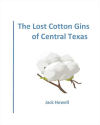
The Lost Cotton Gins
of Central Texas
Jack Howell
The Lost Cotton Gins of Central Texas, by Jack Howell. 148 pages. Publisher: CreateSpace Publishing (October 25, 2010) A full-color photographic tour of more than 40 abandoned cotton gins in Central Texas serves as a vehicle to examine the history of cotton production in Central Texas, and its rise and fall as an economic driver in the region.
Short histories of controversies, attempted monopolies, and technical advances in cotton production are given, along with discussions of how these have continued into the present. An aside even shows that extraterrestrials may have an interest in Texas cotton.
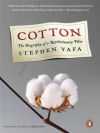
Cotton
Stephen Yafa
Cotton: The Biography of a Revolutionary Fiber, by Stephen Yafa. 416 pages. Publisher: Penguin (Non-Classics) (June 27, 2006) In the tradition of Mark Kurlansky's Cod and Salt, this endlessly revealing book reminds us that the fiber we think of as ordinary is the world's most powerful cash crop, and that it has shaped the destiny of nations. Ranging from its domestication 5,500 years ago to its influence in creating Calvin Klein's empire and the Gap, Stephen Yafa's Cotton gives us an intimate look at the plant that fooled Columbus into thinking he'd reached India, that helped start the Industrial Revolution as well as the American Civil War, and that made at least one bug—the boll weevil—world famous. A sweeping chronicle of ingenuity, greed, conflict, and opportunism, Cotton offers "a barrage of fascinating information" (Los Angeles Times).

Cotton
Beverly Lemire
Cotton, by Beverly Lemire. 192 pages. Publisher: Berg Publishers (April 15, 2011) This book explores the fascinating history and present-day practices associated with cotton. This is a story of commercial and cultural enterprise, of the ties and tensions between East and West, of technological and industrial revolution, social modernization, colonialism and slavery. Cotton's history mirrors profound global transformations. And cotton remains one of the most significant mass commodities today.
Cotton's track record on labor conditions in factories and plantations has tarnished its history and reputation, even as cotton clothes became the hallmark of modern industrialized society. Cotton expressed popular fashions and popular politics in dynamic ways. Yet cottons also take other cultural forms and are part of vibrant craft traditions in many parts of the world. This book explores the history, impact and ongoing life of this hugely influential textile.

